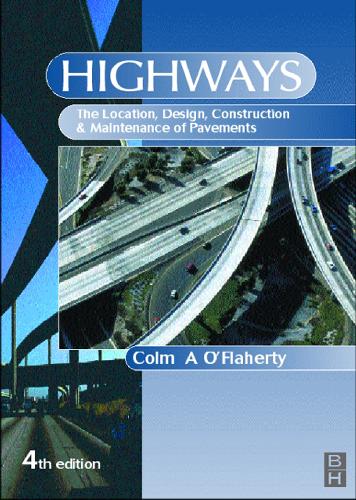Alan Woodside, David Woodward, Coleman A. O’Flaherty9780340691700, 0340691700
Table of contents :
Front Cover……Page 1
Highways: The location, design, construction and maintenance of road pavements……Page 4
Copyright Page……Page 5
Contents……Page 6
About the contributors……Page 12
Acknowledgments……Page 16
Introduction: A historical overview of the development of the road……Page 18
1.1 Complexity of the location process……Page 23
1.2 Overview of the location process……Page 24
1.3 Location surveys in non-built-up locales……Page 25
1.4 Road location in built-up areas……Page 38
1.5 Locating water crossings……Page 40
1.6 Aerial photography……Page 42
1.7 Other remote sensing techniques……Page 47
1.8 References……Page 49
2.1 Investigation aims……Page 51
2.2 Sequencing of the investigation……Page 52
2.3 Subsurface exploration methods……Page 60
2.4 Preparing the main report……Page 68
2.5 References……Page 69
3.1 Classical steps in preparing a programme for a major road: an overview……Page 70
3.2 Documentation of a major road improvement project……Page 75
3.3 The European dimension……Page 81
3.4 References……Page 82
4.1 Soil formation and types of soil……Page 83
4.2 Soil profiles……Page 87
4.3 Soil particles……Page 89
4.4 Soil water……Page 94
4.5 Soil phase relationships……Page 97
4.6 Frost action in soils……Page 100
4.7 Identification and description of soils in the field……Page 106
4.8 Soil classification……Page 110
4.9 Basic soil tests……Page 116
4.10 Soil testing: a comment on the European dimension……Page 132
4.11 References……Page 133
5.1 Penetration-grade refinery bitumens……Page 135
5.3 Cutback bitumens……Page 144
5.4 Bitumen emulsions……Page 145
5.5 Road tars and tar-bitumens……Page 147
5.6 Modified bitumens……Page 149
5.7 Cements……Page 153
5.8 Limes……Page 155
5.9 Conventional aggregates……Page 156
5.10 Secondary aggregates……Page 170
5.11 References……Page 176
6.2 Mechanical stabilization……Page 180
6.3 Cement stabilization……Page 187
6.4 Lime stabilization……Page 192
6.5 Construction of cement- and lime-treated courses in pavements……Page 196
6.6 Bituminous stabilization……Page 199
6.7 References……Page 201
7.1 Importance of surface drainage……Page 202
7.2 Types and uses of surface drains……Page 203
7.3 Estimating the surface run-off……Page 208
7.4 Draining the carriageway……Page 223
7.5 References……Page 225
8.1 Why subsurface moisture control is so important……Page 227
8.2 Protecting the road pavement and foundation……Page 228
8.3 Designing and laying conventional longitudinal subdrains……Page 235
8.5 Geotextiles in drains……Page 239
8.6 References……Page 240
9.1 Evolution of the road pavement……Page 242
9.2 The component layers of a road pavement: types and functions……Page 246
9.3 Some basic considerations affecting pavement design……Page 251
9.4 Flexible pavement design methods……Page 272
9.5 Rigid pavement design considerations……Page 276
9.6 References……Page 281
10.1 Establishing the horizontal and vertical alignments……Page 284
10.2 Earthworks quantities……Page 285
10.3 Balancing earthworks quantities……Page 288
10.4 Excavation and earthmoving equipment……Page 293
10.5 Compaction specifications……Page 295
10.6 Compaction equipment for earthworks……Page 296
10.7 Constructing embankments on soft soils……Page 303
10.8 Materials used in embankments……Page 311
10.9 Preparing the subgrade……Page 312
10.10 Unbound capping and subbase layers……Page 315
10.11 Unbound roadbases……Page 316
10.12 References……Page 318
11.1 Advantages and disadvantages of standard ‘recipe-type’ specifications……Page 320
11.2 Harmonization of European standards……Page 321
11.3 Mechanisms by which asphalts and coated macadams distribute traffic stresses……Page 322
11.4 Standard ‘recipe-type’ specifications currently used in the UK……Page 323
11.5 Possible future standard wearing course materials……Page 339
11.6 References……Page 340
12.2 Standard ‘recipe’ approach……Page 342
12.3 Engineering design approach……Page 343
12.5 Terms used in bituminous mix design……Page 344
12.6 Marshall method of mix design……Page 349
12.7 Advanced mix design methods……Page 357
12.8 Construction methods for hot-mix hot-laid bituminous materials……Page 370
12.9 References……Page 376
13.2 Preparing the foundation……Page 379
13.3 Placing the forms for conventional paving trains……Page 381
13.4 Joint assemblies and reinforcement……Page 382
13.5 Preparing the concrete……Page 383
13.6 Placing and finishing the concrete……Page 384
13.7 Texturing of running surfaces……Page 389
13.9 Other pavements with concrete……Page 390
13.10 References……Page 392
14.1 Introduction……Page 394
14.2 Foundation design……Page 395
14.3 Traffic assessment……Page 398
14.4 Thickness design of pavements……Page 402
14.5 References……Page 410
15.1 Introduction……Page 412
15.2 Pavement design period and design loading……Page 414
15.3 Structural analysis of layered elastic systems……Page 419
15.4 Design criteria used in analytical methods……Page 420
15.5 Pavement material and subgrade properties required for structural analysis……Page 422
15.6 Layer characterization for purposes of structural analysis……Page 428
15.7 Damage computations and performance models……Page 432
15.9 References……Page 436
16.2 Subgrade……Page 441
16.4 Modulus of subgrade reaction……Page 442
16.5 Plate bearing and CBR testing……Page 443
16.6 Fibre-reinforced pavement quality concrete……Page 444
16.7 Thermal and moisture-related stresses in concrete slabs……Page 445
16.8 Crack control methods……Page 451
16.10 Mechanistic rigid pavement design……Page 453
16.11 Some research results……Page 460
16.12 Design of concrete block paving……Page 464
16.13 References……Page 468
17.1 Importance of maintenance……Page 469
17.2 Scope of road maintenance……Page 471
17.3 Maintenance management systems……Page 473
17.4 Maintenance rating systems for bituminous roads……Page 477
17.5 Maintenance rating systems for concrete roads……Page 480
17.6 Maintenance of bituminous pavements……Page 481
17.7 Maintenance of concrete pavements……Page 484
17.8 Maintenance of unsurfaced soil–aggregate pavements……Page 485
17.9 Maintenance of other roadway features……Page 486
17.10 Winter maintenance operations……Page 490
17.11 External influences on maintenance operations……Page 492
17.13 References……Page 494
18.2 What is wet skid resistance?……Page 496
18.3 Why should the highway engineer consider wet skid resistance?……Page 497
18.4 Development of methods to measure wet skid resistance……Page 500
18.6 The mechanics of wet skidding……Page 501
18.7 The measurement and prediction of wet skid resistance……Page 506
18.8 A critical evaluation of the PSV test method……Page 511
18.9 The contact patch: understanding what happens……Page 512
18.10 Conclusions……Page 514
18.11 References……Page 515
19.1 Surface treatment types and purposes……Page 517
19.2 Surface dressings recommended in Road Note 39……Page 518
19.3 Factors affecting the use of surface dressing systems……Page 521
19.4 Theory underlying the design of surface dressing……Page 522
19.5 Applying surface dressing and avoiding failure……Page 526
19.7 Thin surface treatments……Page 528
19.8 References……Page 530
20.2 Concept of pavement strengthening……Page 533
20.3 Structural assessment procedure……Page 534
20.4 Use of deflection measurements……Page 538
20.5 Use of deflection–life relationships……Page 541
20.6 Overlay design methods for flexible pavements……Page 546
20.7 Overlay design methods for concrete pavements……Page 554
20.8 References……Page 561
Index……Page 564







Reviews
There are no reviews yet.